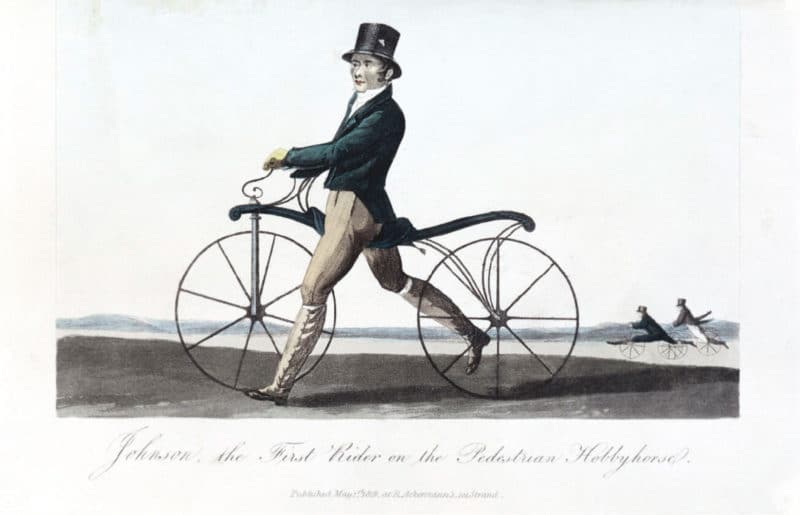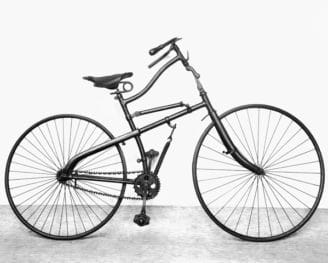DAVIDSON HISTORY
Davidson: The Bicycle Town

The Pedestrian Hobbyhorse
Since Davidson is known as such a bicycle town, I thought it would be interesting to look into the history of bicycles and when they first appeared in great numbers here in town.
The first attempt at a “bicycle,” or human-powered conveyance with two wheels, was made by a German named Baron Karl von Drais. His Laufmaschine (running machine) first appeared in 1817. It was actually propelled not by pedals but by a person mounting it and running along the road. Sometimes also called a velocipede, it was the first successful two-wheeled, steerable vehicle propelled by humans. Initially manufactured in Germany and France, it was nicknamed the hobbyhorse or dandy-horse.
In 1853 a French metalworker invented the first such machine propelled by rotary cranks and pedals, and two years later riders in the South were using them. In 1855 a bookstore in Raleigh was selling velocipedes, and by 1869 they were quite popular among young men for exercise and racing. According to the June 23, 1869 edition of South Carolina’s Newberry Herald, a reporter had recently visited the local practice rink, and was not impressed: “The Velocipede is a first rate institution, and to get up a good sweat, it can’t be excelled; some people take to it rapidly, and those who like it, find it very exhilarating. For us, the exercise is rather violent…The construction of the bycicle [sic] is unfortunate, it can’t stand without help, and aside from its stripes and colored paints, for simplicity, moral excellence, capacity and general adaptability to the wants of mankind, we give the preference to the wheelbarrow.” Bikes were apparently becoming a nuisance, because that same month, Columbia, South Carolina instituted a $5 fine for riding a velocipede on the pavement.

The Ordinary Bicycle
The next advancement was the high-bicycle, invented by Eugene Meyer in 1869. His invention featured wire-spoke tension wheels, and featured a large front wheel, a small back wheel, and a lighter frame. This increased the speed. The high-bicycle was run by direct front wheel drive, which limited its speed. So, inventors began to experiment with chain-driven front or back wheels. Harry John Lawson invented a rear-chain-drive bicycle with a large front wheel in 1879, but it was not successful. Charlotte had a bicycle club as early as 1882, and by the mid-1880s, there were bicycle tournaments, races and exhibitions all over the Carolinas.
One of the biggest advancements came in 1885, when John Kemp Starley produced the first “safety bicycle” called the “Rover.” It had equally-sized wheels and a chain-drive rear wheel. In 1888 John Dunlop invented the pneumatic bicycle tire, which made the ride much more comfortable. In October of 1869, an African-American inventor by the name of Isaac R. Johnson patented a folding bicycle, the first with the diamond-shaped frame that we recognize today. By 1890, the safety bicycle had replaced the high-wheeler all over Western Europe and North America.
In May of 1891, Raleigh’s Daily State Chronicle published an advertisement for Columbia tandem tricycles and Ladies’ Safety Bicycles, priced at $250 and $135 respectively. The merchant suggested that Raleigh should organize a ladies’ bicycle club and recommended a number of pamphlets for prospective women riders. These included Nelly Bly’s “On a Bicycle,” Dr Lucy Hall’s “The Cycle for Women,” and “What to Wear” by Daisie.
In the summer of 1894, what the Davidsonian referred to as the ‘bike’ craze “struck the town with full force…although the place isn’t flooded with wheels, there are a good many enthusiasts.” Mooresville had challenged Davidson to a race, but since Davidson didn’t have a good track, it seemed unlikely. There was talk of building a track and, according to the writer, “if this is obtained, Mooresville will most probably regret her challenge.”
According to the Davidsonian, by January 1897, at least one woman had joined the ranks of cyclists. Julia Holt had purchased a Crescent ’97 model, and “is learning to ride very fast, as she

Spring frame patented by O Macarthy in 1885.
can be seen through the parlor window… spinning back and forth at a lively rate.”
According to the Raleigh News and Observer, by July of 1897, “wheelmen [were] plentiful among the Predestinarians” at Davidson College. The “crack” bicycle club was composed of fifteen students and five members of the faculty, with Dr. J. P. Munroe, president of the medical college, as one of the leading cyclists. The paper reported that “In the village there are about 21 other wheels, eleven gentlemen’s and ten ladies. In point of roads Davidson excels. A large part of the campus is encircled by a fine bicycle track a fourth of a mile in circumference on which any evening of the college session may be seen quite a number of exciting races among the students. The roads to Charlotte and Statesville are exceptionally fine in summer for cycling, being smooth and singularly free from hills.”
Apparently the best riders could cover the forty-mile round trip between Davidson and Charlotte in 1 1/2 hours. According to the February 1898 issue of the Davidson College Magazine, Miss Minnie Schofield was one of the women who had recently begun cycling. The magazine reported that “There are now ten or twelve of our town ladies who ride wheels, and we can’t see why they do not organize a club and go at it sure enough. Realizing the destructible condition of the roads at some seasons, we would gladly tender you our campus circle, ladies.”
Nancy Griffith
Nancy Griffith lived in Davidson from 1979 until 1989. She is the author of numerous books and articles on Arkansas and South Carolina history. She is the author of "Ada Jenkins: The Heart of the Matter," a history of the Ada Jenkins school and center.


